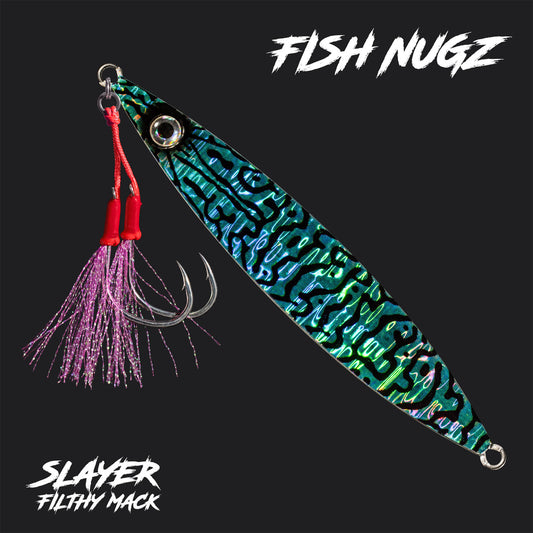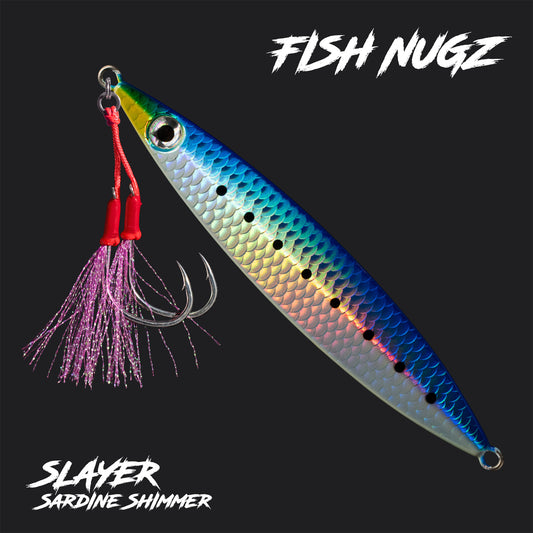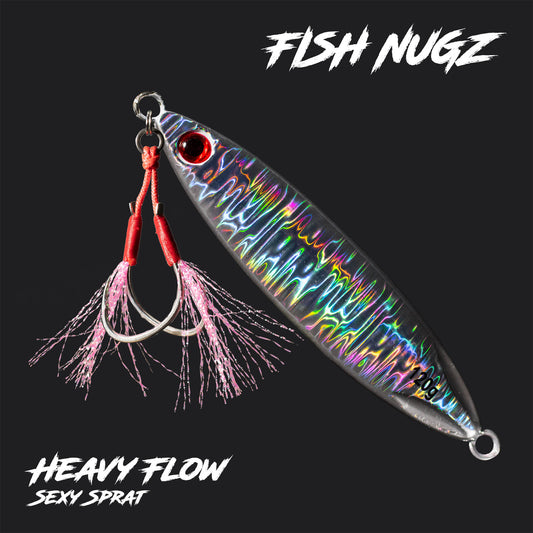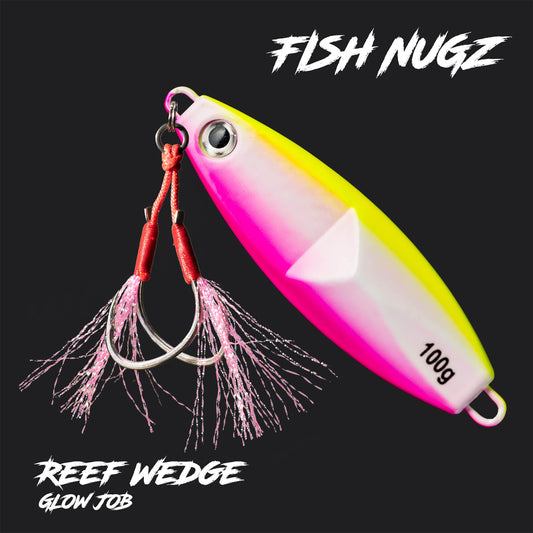Want to catch more fish? You need to start Slow Jigging! This is a unique method of jig fishing that is putting more and more fish on anglers boats and kayaks. It's fun, it's addictive and it can catch fish when other methods are struggling to get a bite. You can find out all about Slow Jig fishing in this introductory guide to slow jigging...
What is Slow Jigging?
Slow Jigging (also known as Slow Pitch Jigging or SPJ) is a technique of jig fishing with metal lures that originated in Japan. It is now a style of fishing used by anglers all over the world, and for good reason... it can catch fish when other methods are struggling to get a bite! This is because slow jigs are designed to catch fish that are both actively feeding and also those that are not switched onto feeding! So how do they do this? Let us explain...
A short lesson in Fish Feeding Dynamics... A fish may not be actively feeding for a number of reasons. On a biological level this all comes down to energy... if the energy spent searching for food, and catching a meal, is more than the energy the meal will then provide to the fish, then it is not really worth feeding. Perhaps the food source is few and far between, making a feeding attempt hard work for any reward. Perhaps the tidal conditions mean that a lot of energy needs to be spent to find and catch food. Maybe the fish is full up and not needing to go on the search for food at all. In basic terms, it needs to be worthwhile for the fish to feed. But... an opportunistic meal for little energy expenditure proves irresistible to many fish, whether they are switched onto actively feeding or not!
One of the easiest meals a predatory fish can get is an injured or distressed baitfish limping and flailing erratically with limited ability to escape! Slow Jigs are designed to mimic this very action with fluttering and erratic flailing as they fall through the water. The shimmering vibrations given off by the jig will grab the attention of most predatory fish, whether they are feeding or not, and induce that primal instinct to grab an easy meal!
We can summarise here... Slow Jigging is a method of fishing that uses a metal jig to mimic a distressed or injured baitfish, and present a predatory fish with an easy meal to strike. This works great for catching fish that are both looking for food and those who are not actively on the feed, meaning that Slow Jigging can often work when other fishing methods are not!
What is a Slow Jig?
Slow jigs are a type of flattened metal lure that tend to be shaped like a teardrop or oval. They are usually centre-weighted on one side of the jig, forcing them to fall on one-side and inducing the fluttering action. Slow Jigs come in various weights, with lighter sizes great for shallow waters and heavier sizes needed for effective fishing in deep waters.
Slow Jigs also come in a range of shapes and styles. Different shaped jigs will create different fall patterns. Wider oval jigs tend to flutter just as a leaf would fall through the air, with more 'hang-time' in the water than narrower teardrop shaped jigs. Narrow jigs tend to zig-zag back and forth as they tumble through the water. Different shaped jigs work better at certain times than others. Narrower jigs cut through the water quickly and can work better in heavier tidal flows or when you are drifting faster. Wider jigs work best over slack water when you can keep your line directly above the jig to impart maximum fluttering action.
Slow Jigs are rigged with high quality single or twin assist hooks usually mounted at the top of the jig. In some cases jigs will be rigged on both top and bottom with assist hooks to maximise the chance of hooking up! The assist hooks are fitted to a solid ring and the jig clips to this via a split ring.
A wide array of slow jigs are now available with different weights, colours and fall patterns to suit different fishing grounds, different water conditions and different species. It is always good to carry a good selection of slow jigs so you can jig for for longer over changing tidal conditions, and fish more effectively over different grounds. The Wild Seas Fish Nugz range of slow jigs offers plenty of choice to cover all slow jigging situations and fish species!

A selection of Fish Nugz Slow Jigs - different shapes, weights and colours for an array of situations and target species
How to fish with Slow Jigs?
Slow jigs are worked by firstly drawing the jig up through the water, known as pitching the jig (hence the name, Slow Pitch Jigging). This is best done by lifting the rod and loading the blank with the weight of the jig. You then let the rod blank recover, which at same time pulls the jig up through the water. You then allow the jig to flutter back down on a slack line as you lower the rod to repeat the slow jigging process. You can fish Slow Jigs at the same depth or more commonly with a slow retrieve by gaining a half wind or full wind of the reel handle with each lift of the rod. Note that the turn of the handle is taken on the lift... This aids the jig being pulled up through the water, and with a little practice of the technique you can time the turn of the handle and final flick of the rod tip to really launch the jig upwards for maximum flutter fall time!
There are no hard and fast rules on how to slow jig but the principle remains the same of pitching the jig up and then allowing it to fall back down on a slack line to impart the erratic falling action. There are loads of variations you can put into play when working a slow jig. Experiment with the length of the lift, speed of the lift and retrieve rate to try and entice a bite!
What tackle do I need for Slow Jigging?
There are specialist Slow Jigging rods and reels now available from many manufacturers, but if you want to start slow jigging, you don't need to rush out and buy a dedicated set up. You can still use Slow Jigs effectively using any standard lure rod and reel set up. For the occasional slow jig work, most general lure fishing rods will suffice, you will just have to adapt the slow jigging technique to ensure you get the best action from the jig with your chosen rod. I am often fishing slow jigs on a Penn Conflict XR Inshore 7ft 5in fast action lure rod rated to 50g paired with a Penn Slammer 3500 fixed spool loaded with braid. This is a versatile set up for all sorts of lure fishing with soft plastics, hard lures and metals such as slow jigs.
Specialist Slow Jigging rods tend to be around 6ft in length with a slow taper parabolic 'through' action that will bend right through the butt with a good fish on. These are lightweight yet strong making use of high quality carbon blanks.
Slow Jigging reels tend to be small narrow-spooled multiplier style reels with a large handle to make retrieve in deep water easier, but bait caster style reels are also now proving popular too thanks to the instant jig drop ability with the thumb spool-please button. It is important to have a reel with strong and smooth drag to cope with battling large fish on the relatively light jigging light rods. But why not just use a stronger rod for bigger fish?... Well, a slow jigging rod is designed to work the lure and the reel is designed to play the fish. It is much easier to work a lighter rod all day than a heavy blank that tires you out.
Whilst easy to work, you need to exercise some caution when fishing with light blanks. Strong pumping or high sticking on a powerful fish can risk a snapped rod so keep an eye on your rod position (don't go too high!) and let the reel do the work of tiring the fish. Set the drag just right for your intended quarry and the reel will do the work for you. A proper slow pitch fishing set up can be worked and fished with all day long without tiring out. If you want to start regularly slow jigging then it may be worth investing into a proper slow jigging set up.
For slow jigging in the UK we have found the Penn Conflict Jigging 200g Cast rod paired with the Penn Fathom Low Profile 300 reel to be a fantastic combination that is both easy to work all day long and very sporting on UK fish.

The Penn Conflict Jigging 200g Cast rod paired with the Penn Fathom Low Profile 300 is a great combination for slow jig fishing in the UK. Photo: Wild Seas Liam hooked into a decent fish whilst slow jigging from a boat
Make sure you fill your reel with braid, it is essential for slow jigging. It keeps you in direct contact with the jig and this is very important to get the full feel for how the jig is behaving and instant indication as soon as a fish hits so that you can set the hooks. A fish will usually hit the jig as it is falling or during the short pause before you lift the rod again. You want to connect and hook-up to the fish straight away as sometimes hits can be short and sharp as a fish makes a quick swipe at the jig. Sometimes you just get nailed with no warning! You go from a free-falling jig to full rod bend as you start to lift the rod again... this is where it really gets addictive!
All you need to do now is add a short length of mono or fluorocarbon leader to offer some resistance against any rough structure that you may have to work the jig over, and then add your chosen slow jig. A slow jig can be attached to the leader either by directly tying the line to the solid ring of the assist hook, or by making use of a strong swivelled lure clip to attach to the solid ring.

Simply tie your Slow Jig to your leader line via the solid ring on the jig. Jig shown is a Fish Nugz Heavy Flow in Candy Flash colour
Where to fish with Slow Jigs?
Slow Jigs are most effective when worked close to the seabed, and certainly in the lower third of the water column. This is particularly the case when fishing around reefs and rough ground, where non-feeding fish may be resting or taking refuge amongst the bottom structure. If fishing in open waters for shoaling pelagic fish the slow jigs can be effective when fished in mid-water.
How to fish with Slow Jigs?
Slow Jigging is most effective when you can keep your line and rod tip directly over the jig. This is a massive part of successful slow jigging, so try to keep your line as vertical as possible whilst working the jig! This allows you to impart the full lift-fall action so that the jig will flutter and flail best.
Slow jigging is best done from a boat or kayak. Smaller and lighter slow jigs can be effectively fished from the shore on some marks, especially if there is a bit of depth to cast and fish into.

Slow Pitch Jigging is an effective method to use from boats or kayaks. Photo: Wild Seas Liam hooked into a fish whilst slow jigging from his kayak.
The speed of your drift plays a big role in how effective you jig can be fished, so it is important to take note of the tide and wind conditions. Slow Jigging becomes less and less effective as the angle between your jig and your line becomes shallower. The jig will stop falling correctly and will not flutter as well. Less flutter = less fish! Try to keep the line vertical as much as possible as this means you will be fishing the jig at it's best! You'll also be less likely to get snagged by fishing the jig vertically. As the angle shallows, the lift of the lure becomes less vertical and more diagonal across the bottom... more chance of hitching up on rocks or weed! Even with your best attempts to avoid getting snagged up, every now and then you will lose a jig. Don't worry though... if you lose some jigs, you can replenish your losses right here at Wild Seas!
Fishing either side slack water proves the best as you can keep your craft right over the spot the jig is working. As the tide or wind increases your drift speed, you can prolong your slow jigging time by going to heavier jigs or jigs that have a slimmer profile to cut through the water easier, meaning they stay under the craft more effectively. Be sure to have a good selection of jigs in your tackle box!
What can I catch on Slow Jigs in the UK?
Slow Jigging is a great way to catch fish here in the UK, and the team at Wild Seas absolutely love it! We have been slow jig fishing for many years and have caught a huge array of species including some impressive specimens. It is a really effective way to target fish in our cold waters.

A fine Pollack caught by Wild Seas Liam using a Fish Nugz Full Mast Jig worked in mid-water over a reef
Often fish will be docile between times of active feeding, seeking cover near the bottom and not wanting to use much energy. Dancing a slow jig in front of them will often tempt them to strike and we have found this method excellent for catching Bass, Pollack, Cod, Ling, Coalfish, Whiting, Haddock, Ballan Wrasse, Cuckoo Wrasse, and various species of Gurnards.

Wild Seas Liam with a big Ling caught whilst fishing over a wreck with a slow jig
We have even caught some rarer fish on slow jigs including magnificent John Dory and even a Megrim Sole!
Slow Jigging is a super effective way to fish UK reefs, wrecks, rough ground and at times clean ground too. Get involved in the fun world of Slow Jigging and get your rod bent! You never know what you may catch!
Can I use Slow Jigs abroad?
Slow Jigging has accounted for hundreds of different species across the globe, from hard fighting reef dwellers such as Snappers and Groupers to high-speed pelagics including Tuna, GT's, Wahoo, Sailfish and more! The Wild Seas team have fished slow jigs in Panama and Madagascar and have caught world-record sized Cubera Snapper, Blue Trevally and Broomtail Grouper! Take some slow jigs abroad and see what you can hook into.

A HUGE Cubera Snapper caught Slow Jig fishing in Panama by Wild Seas Kieren.

A big Broomtail Grouper caught Slow Jig fishing in Panama by Wild Seas Sam.
Where to buy Slow Jigs?
Wild Seas sell a wide range of slow jigs in various shapes and styles so that you can be equipped for all slow jigging situations. View our full range of Slow Jigs by clicking here.
If you need any assistance in choosing jigs just get in contact with the Wild Seas team and we can advise you on the best slow jigs









